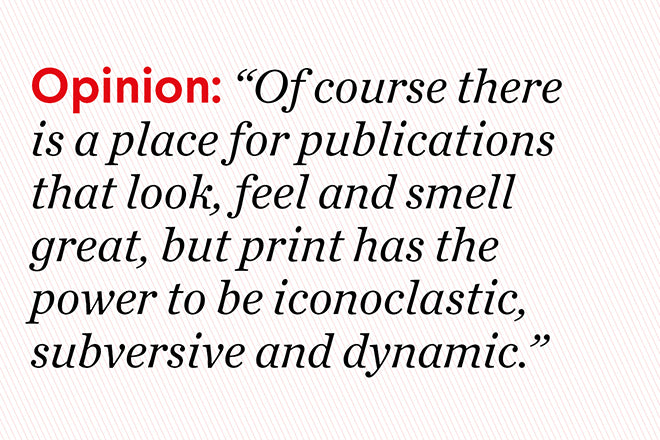
Is it enough for magazines to be lifestyle objects?
It’s the start of a new month and time to hear from our regular columnist Rob Alderson. Today he asks whether it’s enough for indie mags to be aesthetically satisfying lifestyle objects. What happened to iconclasm?
A couple of weeks ago it was revealed that almost half of the people who buy vinyl records in the UK don’t actually listen to them. The survey – conducted by the BBC and ICM Unlimited – found that 48% of vinyl buyers don’t play their records. 7% don’t even own a turntable.
For those who love to sneer at hipsters, here was yet more evidence for the prosecution. It pointed to a by-numbers culture that has long-ago sacrificed the authenticity it waves as its standard; in its place a collection of tepid, soulless, tick-box touchstones masquerading as some sort of millennial movement.
Back in 2013 a Quartz piece titled “Hipsters are buying vinyl records, but they aren’t listening to them” made the point that while vinyl sales were exploding, sales of turntables had stayed relatively flat. The author’s conclusion though was more charitable than some of the responses to the BBC survey. “In an increasingly digital world, there’s not only charm and soul in the retrosound of wax, but it’s also found in the 12” physical art that comes with them,” he wrote. “The further we dive into the digital, virtual world, the more ironic and iconic the physical manifestation of music (and information for that matter) becomes.”
So vinyl, he suggested, wasn’t really about the music per se, it was actually about the cultural import of collecting, owning, and, as he goes on to admit, displaying. “From Williamsburg to Portland, our musical choices define some part of our identities and displaying these choices, along with our apparent respect for the value of music, makes our identities non-virtual.”
In the inevitable Guardian thinkpiece that followed the BBC report, DJ and music journalist Hanna Hanra made a similar point. “I’ll admit that on some level, as with the ownership of many physical things, it’s a status symbol,” she wrote. “No one knows that I’m listening to Mariah Carey at the back of the bus – but they do know, because I’ve shared it on Instagram, that I bought the Björk re-issue of Post on pink vinyl not all that long ago. And to my utter shame, it’s still in the plastic.”
There is an honesty too about Jordan Katende, a vinyl collector without a turntable who talked to the BBC about his hobby. He explained how he will often go and listen to the album online, so for him the music and the manifestation were completely separate entities.
When I tweeted a link to the BBC story, more than one person made the point that people who buy magazines don’t always read them either. In fact over the months I have been writing this column, a recurring criticism has been that I am too focussed on seeing magazines as reading material rather than collectible objects.
I am happy to admit that I can get my head round spending £10/15/20 on something that is just going to sit on my shelf. It is important though to differentiate between magazines that the buyer hasn’t yet got round to reading, but fully intends to, and those bought for purely aesthetic reasons.
Of course it’s hard to draw comparisons, but if the proportion of magazine-buyers who don’t read their purchases is anything like the 50% of vinyl buyers who don’t play their records, then maybe that is something for magazine-makers to consider. It’s fair to say that many independent titles have become lifestyle objects. There is an achingly trendy concept store near where I live in Amsterdam, one of those confusing emporiums that seems to sell clothes, candles and antique watering cans. It stocks three indie magazines and I would bet that most of you would be able to name them.
Maybe this isn’t a problem in and of itself. Isn’t it nice that we can have nice things? Well yeah, up to a point. But there are already voices of discontent about how indie publishing is starting to homogenise around a formulaic version of what a magazine looks like. Of course there is a place for publications that look, feel and smell great, but print has the power to be iconoclastic, subversive and dynamic. Put down a copy of The Outpost and you think differently about the Middle East. That has to be more interesting than an antique sodding watering can right?


